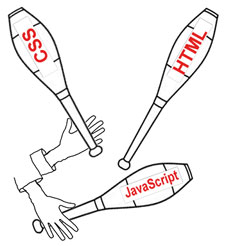HTML5 promises possibilities for designing websites and apps, which have almost remained unimagined until now. Although it is not an official standard, Internet providers and web developers are already using HTML5. Many authoring tools are now capable of creating HTML5. Reason enough to take a closer look.
The term “HTML5” means much more than the Hypertext Mark-up Language that it stood for originally. A simple definition could be: HTML5 is HTML, CSS3 and JavaScript.
HTML5 is a bundle of technologies, which are related only in the context of HTML, strictly speaking. The Hypertext Mark-up Language is extended to include many new elements, such as <video>, <svg>, <source> and <canvas>. The elements in turn come with their own elements, which can make up the full scope of HTML5 only through new JavaScript methods and JavaScript frameworks. This includes the layout language CSS3, soon CSS4, which is becoming more and more powerful. The language has also been expanded through new design elements. These elements ensure that a website can be rendered well even on a Smartphone.
The table below provides an overview of the scope of the technologies, which are more or less closely allied with ...
Read more after login
tekom members can log in directly with their "My tekom" access data.
You are not yet a tekom member, but would like to read one or more articles in full? Then you have the opportunity to register on the internet portal of the technical journal 'tcworld' without obligation. Once you have registered, you can select any three specialist articles and view them in full for a period of two months. The selection will then be deleted and you can select three new articles for the next two months.
As a tekom member you benefit from the following advantages::
- Online access to all articles of the trade magazine 'tcworld magazine'
- Exclusive specialist articles from all areas of technical communication
- Regular new articles from over 300 authors
- The technical journal 'tcworld magazine' as a printed edition
- Reduced admission prices to tekom conferences
- Membership fees for tekom publications
- Access to 'my tekom', the web forum with job offers / job requests, appointments, expert advice, service provider file and much more
Login
Registration
Promised: The trade magazine 'tcworld magazine' is the best we have. And we don't make the choice easy for ourselves. Every month, the editorial staff of the technical journal 'tcworld magazine' publishes the latest articles by renowned authors. This demanding selection is available exclusively to members of tekom (as usual, including the printed edition).
The trade magazine 'tcworld magazine' stands for intelligently prepared specialist articles, texts written to the point, informative content, surprising insights, international perspectives and communicates technical communication in an understandable, fast, clear and uncomplicated way - exclusively for you.

